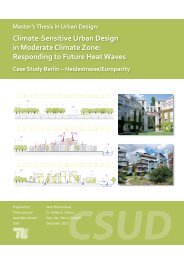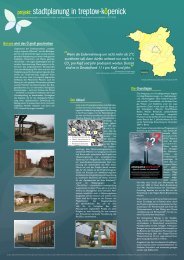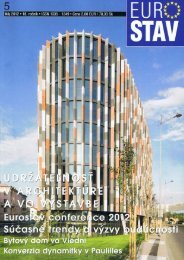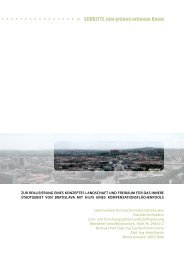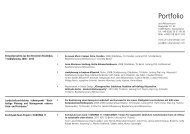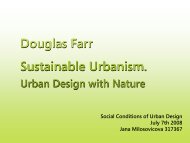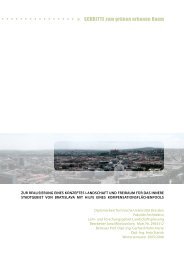Bausteine - Referate - Jana Milosovicova - Urban Design English
Bausteine - Referate - Jana Milosovicova - Urban Design English
Bausteine - Referate - Jana Milosovicova - Urban Design English
Erfolgreiche ePaper selbst erstellen
Machen Sie aus Ihren PDF Publikationen ein blätterbares Flipbook mit unserer einzigartigen Google optimierten e-Paper Software.
Sustainable neighborhood rating systems: An international comparison<br />
Die Bewertungsmatrix<br />
There are notable differences between the two<br />
systems: from former is a large-scale effort by<br />
three major nonprofit organizations with 238<br />
pilot projects while the latter is a small-scale<br />
university project. The systems were developed<br />
within the context of their respective countries’<br />
rules, regulations and standard practices. Yet despite<br />
the differences in scale and context, both<br />
systems have parallel goals and evaluate similar<br />
criteria focused primarily on environmental sustainability.<br />
The comparison of LEED-ND and the<br />
Assessment Matrix in this paper identifies universal<br />
principles of sustainable neighborhoods,<br />
differing country- or region-specific problems<br />
and best practices for evaluation standards.<br />
Ii. Rating system context and overview<br />
The Assessment Matrix and LEED-ND both<br />
address the city-related climate change issues<br />
– buildings, vehicle travel and land use change –<br />
by trying to lesson sprawl. Yet the differences in<br />
the planning and development context of Germany<br />
and the U.S. results in differing goals and<br />
standards.<br />
The Context<br />
Even though European cities have are considered<br />
more sustainable than their American counterparts,<br />
they also face the challenge of sprawl.<br />
A European Union report, <strong>Urban</strong> Sprawl and<br />
Europe, noted that low density suburban development<br />
in the periphery has become the<br />
norm over the past 20 years in Europe. Sprawl<br />
continues over the available land remaining,<br />
using large amounts of resources for relatively<br />
few people and leading to a loss of biodiversity<br />
(EU, 2006).<br />
In Germany, the character of sprawl may be a<br />
solely residential area near the edge of town<br />
that is located just too far to walk or bicycle to<br />
the town center and with neighborhood commercial<br />
limited to an Aldi at the edge of town.<br />
This picture is still quainter than the image of<br />
the American suburb with large vinyl McMansions<br />
on cul-de-sacs that are located a 20 minute<br />
drive along 8-lane arterials away from a<br />
paradise of big box retail. The former is only<br />
moderately automobile dependant; the latter is<br />
completely automobile dependant and consumes<br />
more land per person.<br />
Planning History<br />
Germany and the U.S. share a history using<br />
zoning; indeed Germans invented the concept<br />
of dividing the city into residential and industrial<br />
zones which influenced American planners.<br />
German planners originally focused more<br />
on the control of noxious industry, relief from<br />
crowding and the protection of countryside;<br />
U.S. planners shared these goals to some extent<br />
but also concentrated on the protection<br />
of single-family housing. The resulting German<br />
regulations mainly considered bulk and density<br />
and the U.S. primarily evaluated land use incompatibility<br />
(Hirt, 2007). Bernhard Weyrauch, the<br />
main author of the Assessment Matrix, described<br />
the current German planning and cultural<br />
attitude as accepting of some conflict. People<br />
are willing to tolerate some noise in exchange<br />
for the benefit of increased proximity to everything<br />
one needs. Mixed-use neighborhoods are<br />
in the norm in Germany.<br />
However, in the U.S., mixed-use is a recent innovation.<br />
As David Godschalk describes, “The<br />
big news in American city planning is that urban<br />
design has replaced lawyerly limit-setting as<br />
the major reason for regulating development…<br />
major new tools for shaping cityscapes [include]<br />
traditional neighborhood development, mixeduse<br />
districts, and form-based zoning.” (Godschalk,<br />
2007) While mixed-use development is<br />
certainly an increasing trend, it still remains a<br />
small part (5-7 percent) of a typical zoning map<br />
(Hirt, 2007).<br />
Zoning Regulations<br />
Germany has a national building law that regulates<br />
the planning and development process.<br />
This national law defines the standards and process<br />
for land use plans, zoning districts and the<br />
100



